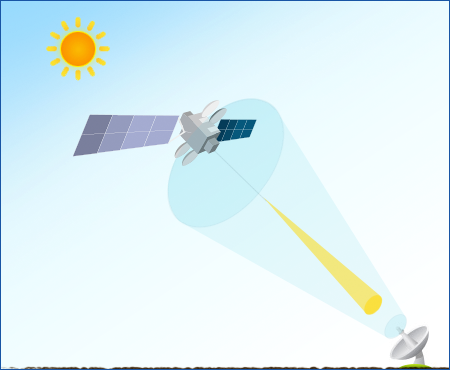- Technical Tools
Technical Tools
Sun Interference
Sun interference that occurs during spring and autumn equinox seasons can cause degradation in the quality of communication links utilizing geo-stationary satellites.
Receiving earth station antennas that are always pointed to a geo-stationary satellites, will receive energy emitted by the sun as the sun passes directly behind the satellite antenna. This energy is thermal interference which can cause noise level increase. When the noise level increases, the reception C/N (Carrier to Noise ratio) will decrease, resulting in degradation of the satellite communication link.
Sun interference occurs for several minutes each day during equinox seasons in spring and autumn. The actual start time, duration and degree of impact may vary depending on the conditions such as the location of the receiving earth station, size of the antenna, and characteristics of the receive signal (e.g. frequency, link margin, etc).
For receiving earth stations in the Northern Hemisphere, sun interference occurs for several days just prior to the spring equinox and just after the autumn equinox. The situation is reversed for receiving earth stations in the Southern Hemisphere.
Sun interference occurs during the morning hours for receiving earth stations situated at longitudes west of the satellite orbital position, and during the afternoon for earth stations situated east of the satellite orbital position.
Sun Interference Prediction
Please select the satellite in use and the country in which the receive earth station is located to search for sun interference prediction time table.
Viewers searching for cities not found in the chart or users of vehicle-mounted stations should refer to sun outage predictions by the nearest city listed (interference levels are generally the same if within approximately 40 kilometer radius).
For satellites in inclined operation, sun interference may occur 2 minutes before and/or after the predicted duration (maximum 4 minutes longer than predicted), and also 6 days before and/or after the predicted period (maximum 12 days longer than predicted).
Satellite Polarization Skew (Tilt Angle)
Some of the JCSAT and Superbird satellite’s polarization plane are tilted by an angle with respect to the equatorial plane. This tilt is called by various names, such as ‘Sat Skew’, ‘Pol Skew’, ‘Skew Offset’, ‘Tilt Angle’ and so on.
Customers are required to set the Satellite Polarization Skew when using an auto-tracking antenna.
Center of Box Predictions
Center of Box(=COB) predictions are used for fine pointing of earth station antennas.
Click the link below to find COB predictions for your satellites.
Operational Guidelines
Last update : Operational Guidelines Rev 3.4 on May 31, 2025.
All customers, end users and earth station operators of SJC satellites are required to comply with the Operational Guidelines.
Please contact us for the password and username.

